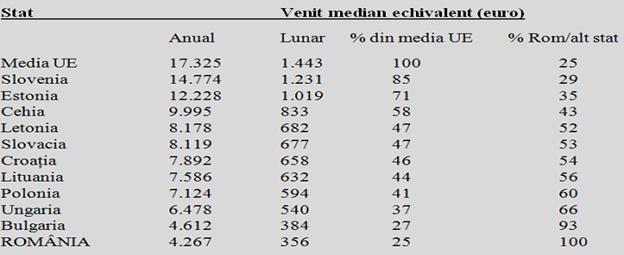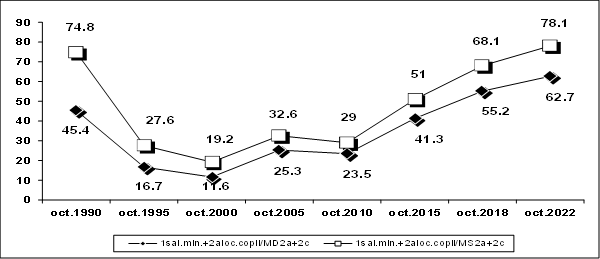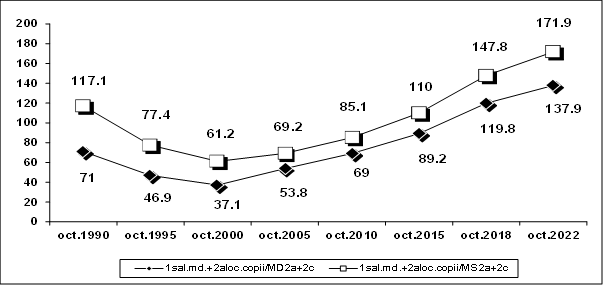eISSN: 2576-4470


Mini Review Volume 7 Issue 3
Department of standard of life, Research Institute for Quality of Life, Romania
Correspondence: Adina Mihailescu, Research Institute for Quality of Life (RIQL) –Romanian Academy, Bucharest, Romania
Received: April 25, 2023 | Published: May 5, 2023
Citation: Mihăilescu A. The standard of living of salaried families in the face of current changes. Sociol Int J. 2023;7(3):99-102. DOI: 10.15406/sij.2023.07.00329
Household incomes are extremely sensitive to unfavorable developments in the economy, as well as to the dysfunctions of the national and world market. The gap between the incomes of Romanians and those of other Europeans is determined by the differences regarding the level and structure of employment but also by the salary policies adopted. The shock caused by the COVID-19 pandemic and the war in Ukraine have exposed the structural vulnerabilities of the economy, including persistent poverty and disparities in economic opportunities across regions and between urban and rural areas, structural rigidities in the labour market, weak fiscal policy and constraints significant institutional that affect the efficient use of resources. Poor and vulnerable households have been disproportionately affected by rising food and energy prices.
Keywords: standard of living, families of employees, income, expenses
Romania and European standards
European statistics provide a clear picture of Romania's dynamics in relation to European standards. The data use very relevant indicators for the diagnosis of the standard of living of the Romanian population in relation to other European countries: GDP per person calculated at purchasing power (PPS) and reported (as %) (Table 1).
|
1990 |
2000 |
2000/1990 |
2015 |
2015/1990 |
Romania |
30,9 |
21,9 |
70,9% |
52,0 |
168,3% |
Bulgaria |
30,6 |
24,2 |
79,1% |
43,7 |
142,8% |
Hungary |
43,8 |
46,1 |
105,2% |
63,5 |
144,9% |
Poland |
34,3 |
40,5 |
118,1% |
63,5 |
185,1% |
Slovenia |
67,5 |
68,2 |
101,0% |
76,7 |
113,6% |
Slovakia |
35,3 |
42,5 |
120,4% |
72,0 |
204,0% |
Czech Republic |
71,3 |
62,0 |
87,0% |
79,6 |
111,6% |
Table 1 GDP at current prices per person (PPS, EU-15 = 100)
Source: Statistical annex of European economy, European commission. Spring. 2016;26–27.1
The initial level of the transition process (1990), for the former socialist countries, showed that they were at considerable distances from the standards of advanced European countries. The biggest gap was registered by: Romania (30.9%), followed by Bulgaria (30.6%) and Poland (34.3%). The smallest gap was registered by the Czech Republic (71.3%) and Slovenia (67.5%).
The first 10 years of transition (2000) were extremely difficult for Romania (21.9%) and Bulgaria (24.2%), which represents a massive impoverishment of the population. The Czech Republic also faced problems as a result of the process of separation from Slovakia. Slovenia was the country that achieved the smallest gap (68.2%).
During the 25 years of transition and integration into the EU (1990-2015), all former socialist countries approached the standards of the 15 most developed European countries. The highest level of living standard, by GDP/inhabitant, is presented by the Czech Republic (79.6%), Slovenia (76.7%), followed closely by Slovakia (72%). With the exception of Slovakia, which is a special case, regarding the spectacular approach to European standards, Poland (from 34.3% to 63.5% of the level of developed European countries) and somewhat more modestly Hungary (from 43, 8% to 63.5%). And Romania, after a dramatic decline in the 90s, later recorded an important increase, but still maintaining approximately half of the advanced European standard, from 30.9% to 52%.
If we take into account only the member countries of the European Union, we have the second lowest gross and net salary, only the Bulgarians having lower remunerations. However, at the European level, Romania ranks 30th out of 45 countries, both in terms of the average gross salary (1,151 Euros) and in terms of the average net salary (708 Euros). We are over the countries of Eastern and South-Eastern Europe - Montenegro, Bosnia and Herzegovina, Serbia, Macedonia, Albania, Kosovo, Belarus, Georgia, Armenia, Azerbaijan, Moldova and Ukraine. We are above the Russian Federation and above Bulgaria (the only EU country below us). At the same time, we are quite close to Central European countries such as Slovakia, Hungary, Latvia and Croatia.2
Romania ranks last in the EU for the median income of its citizens expressed in euros, according to data published by Eurostat, with an annual median income of 4,267 euros and a monthly median of 356 euros. Disposable adult-equivalent income is a household's total income, after taxes and other deductions, that is available for spending or saving, divided by the number of household members converted to equalized adults; household members are equalized or age-weighted using an OECD equivalence scale. As seen in the table below, Romania has a median annual income about 4 times lower than the EU average/year and a median monthly income about 4 times lower than the EU average/month (Figure 1).

Figure 1 Romania has a median annual income about 4 times lower than the EU average/year and a median monthly income about 4 times lower than the EU average/month.
Source: Romania, the last place in the EU in terms of the median income (in euros) of citizens (cursdeguvernare.ro).3

Figure 2 The GDP/capita gap between us and the EU average increased slightly, from 20.0 euros in 2007 to 20.5 euros in 2018.
Source: Romania, the last place in the EU in terms of the median income (in euros) of citizens (cursdeguvernare.ro).3
With an increase in GDP/capita (in euros) Romania had the most spectacular growth (+70%) since integration in 2007, until 2017; above the one achieved by Poland (+57%) and significantly above the results of the Czech Republic (+45%) and Hungary (+32%) (Figure 3).

Figure 3 Romania had the most spectacular growth.
Source: Romania, the last place in the EU in terms of the median income (in euros) of citizens (cursdeguvernare.ro).3
The standard of living of wage earners' families
The shock caused by the COVID-19 pandemic and the war in Ukraine have exposed the structural vulnerabilities of the economy, including persistent poverty and disparities in economic opportunities across regions and between urban and rural areas, structural rigidities in the labor market, weak fiscal policy and constraints significant institutional that affect the efficient use of resources. Poor and vulnerable households have been disproportionately affected by rising food and energy prices, despite capping gas and electricity prices at reduced levels until March 2023 for households with lower average monthly consumption. The solid recovery of the economy contributed to the decrease of the share of Romanians living on less than 6.85 dollars a day at purchasing power parity (PPP) from 2017, to 11.7% in 2022, from 12.1% in 202.4
World Bank: The pandemic was a turning point after decades of poverty reduction
In 2020, an additional 71 million people worldwide lived in extreme poverty.
The Europe 2020 strategy had an essential role in the review of child protection policies, through the proposed target of reducing by at least 20 million the number of people affected by poverty or social exclusion.
The draft of the National Strategy on social inclusion and poverty reduction (2014-2020) shows that:
Poverty is more common among people living in households with dependent children (dependent children are considered people aged between 0-17 years), (in 2020 it reached 25.4%), than in the case of those living in households without children (20.8% in the last year)
In 2020, among households with dependent children, the most affected by poverty were:
Household incomes
The income indicator is decisive in sizing the quality of life of the population. But for some categories of the population, incomes have felt the effects of the current crises. Larger reductions of this indicator were borne by farmers' households, part of pensioners' households, but also those of the unemployed. The shortages were felt much more acutely in the countryside.
The total average monthly income of the Romanian population represented at the level of the III quarter of 20227 the following values: per household: 6,668 lei, and per person: 2,662 lei.
The total expenses of the population were at the level of the third quarter of 2022, on average 5,816 lei per household and 2,322 lei per person, representing 87.2% of the total income level. What is the destination of these expenses we see in the following:
The objective of social protection is to support those in vulnerable situations, to guarantee them a minimum level of income and to provide them with social assistance benefits and social services, in exchange for them fulfilling their responsibilities, the main responsibility for adults of working age being to look for a job with the help of active employment measures.
A minimum net salary and two child allowances relative to the decent and subsistence minimum8 in the urban environment for the family of two adults with two dependent children, in the time period October 1990-2022 (Graph 1).

Graph 1 One net minimum wage and two child benefits relative to the urban living and decent minimum for two-adult family with two dependent children, October 1990-2022.
Source: Calculations performed by the author.8
An average net economy wage and two child allowances relative to the urban living, decent and subsistence minimum for the family of two adults with two dependent children,8 in the time frame October 1990-2022 (Graph 2).

Graph 2 An average net wage per economy and two child allowances relative to the decent and subsistence minimum in the urban environment for the family of two adults with two dependent children, October 1990-2022.
Source: Calculations performed by the author.8
Household incomes are extremely sensitive to unfavorable developments in the economy, as well as to the dysfunctions of the national and world market. The gap between the incomes of Romanians and those of other Europeans is determined by the differences regarding the level and structure of employment but also by the salary policies adopted. The predominantly low level of the population's income did not allow the realization of savings in the years of economic growth before the crisis, which determined the marked degradation of living conditions during the crisis, degradation well below the minimum decent consumption threshold, related to all categories of households. In recent years, single-parent families with one or more dependent children in urban and rural areas are far from covering the minimum basket for a decent life. In order to enjoy a minimum of decent living, this family should supplement their income by more than 50%, if we are talking about a minimum wage on the economy and allowances for the two children. As of 2018, the family of two adults with two dependent children could cover the decent living minimum.
None.
None.
None.

©2023 Mihăilescu. This is an open access article distributed under the terms of the, which permits unrestricted use, distribution, and build upon your work non-commercially.